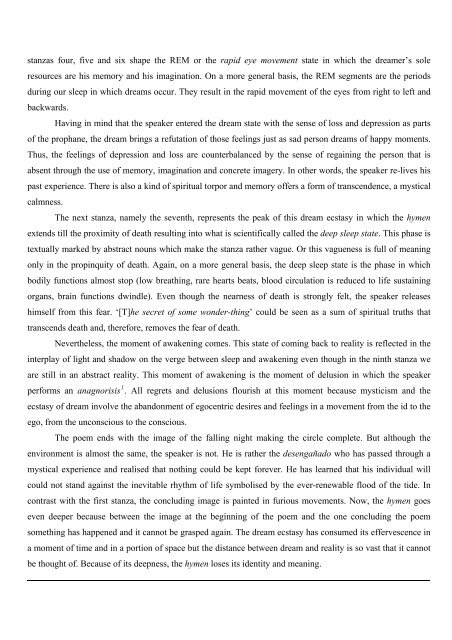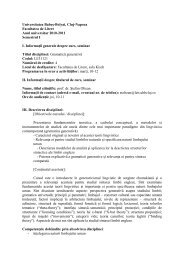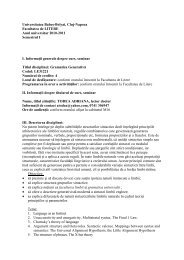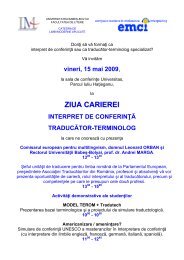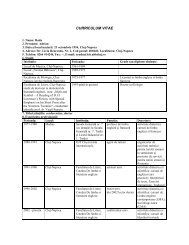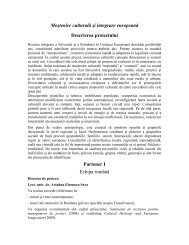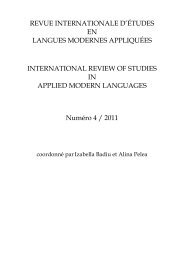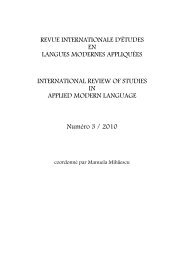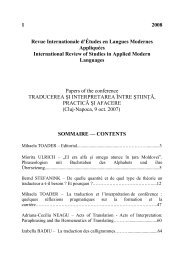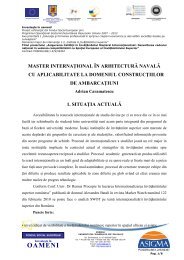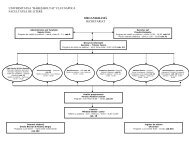Dimensiuni ale limbajului n context carceral
Dimensiuni ale limbajului n context carceral
Dimensiuni ale limbajului n context carceral
You also want an ePaper? Increase the reach of your titles
YUMPU automatically turns print PDFs into web optimized ePapers that Google loves.
stanzas four, five and six shape the REM or the rapid eye movement state in which the dreamer’s sole<br />
resources are his memory and his imagination. On a more general basis, the REM segments are the periods<br />
during our sleep in which dreams occur. They result in the rapid movement of the eyes from right to left and<br />
backwards.<br />
Having in mind that the speaker entered the dream state with the sense of loss and depression as parts<br />
of the prophane, the dream brings a refutation of those feelings just as sad person dreams of happy moments.<br />
Thus, the feelings of depression and loss are counterbalanced by the sense of regaining the person that is<br />
absent through the use of memory, imagination and concrete imagery. In other words, the speaker re-lives his<br />
past experience. There is also a kind of spiritual torpor and memory offers a form of transcendence, a mystical<br />
calmness.<br />
The next stanza, namely the seventh, represents the peak of this dream ecstasy in which the hymen<br />
extends till the proximity of death resulting into what is scientifically called the deep sleep state. This phase is<br />
textually marked by abstract nouns which make the stanza rather vague. Or this vagueness is full of meaning<br />
only in the propinquity of death. Again, on a more general basis, the deep sleep state is the phase in which<br />
bodily functions almost stop (low breathing, rare hearts beats, blood circulation is reduced to life sustaining<br />
organs, brain functions dwindle). Even though the nearness of death is strongly felt, the speaker releases<br />
himself from this fear. ‘[T]he secret of some wonder-thing’ could be seen as a sum of spiritual truths that<br />
transcends death and, therefore, removes the fear of death.<br />
Nevertheless, the moment of awakening comes. This state of coming back to reality is reflected in the<br />
interplay of light and shadow on the verge between sleep and awakening even though in the ninth stanza we<br />
are still in an abstract reality. This moment of awakening is the moment of delusion in which the speaker<br />
performs an anagnorisis 1 . All regrets and delusions flourish at this moment because mysticism and the<br />
ecstasy of dream involve the abandonment of egocentric desires and feelings in a movement from the id to the<br />
ego, from the unconscious to the conscious.<br />
The poem ends with the image of the falling night making the circle complete. But although the<br />
environment is almost the same, the speaker is not. He is rather the desengañado who has passed through a<br />
mystical experience and realised that nothing could be kept forever. He has learned that his individual will<br />
could not stand against the inevitable rhythm of life symbolised by the ever-renewable flood of the tide. In<br />
contrast with the first stanza, the concluding image is painted in furious movements. Now, the hymen goes<br />
even deeper because between the image at the beginning of the poem and the one concluding the poem<br />
something has happened and it cannot be grasped again. The dream ecstasy has consumed its effervescence in<br />
a moment of time and in a portion of space but the distance between dream and reality is so vast that it cannot<br />
be thought of. Because of its deepness, the hymen loses its identity and meaning.


